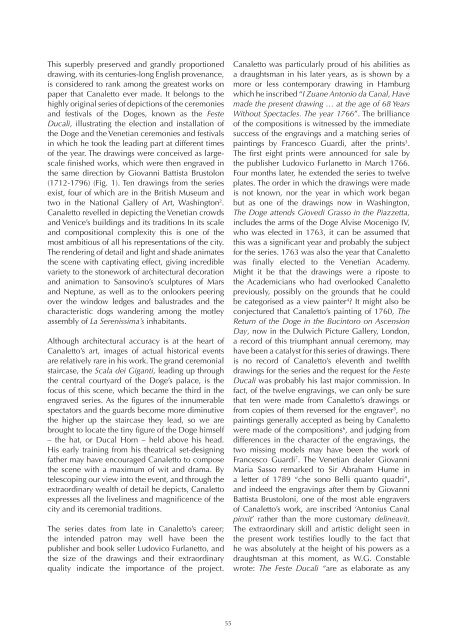Works on Paper 2019 - Jean Luc Baroni
- No tags were found...
You also want an ePaper? Increase the reach of your titles
YUMPU automatically turns print PDFs into web optimized ePapers that Google loves.
This superbly preserved and grandly proporti<strong>on</strong>ed<br />
drawing, with its centuries-l<strong>on</strong>g English provenance,<br />
is c<strong>on</strong>sidered to rank am<strong>on</strong>g the greatest works <strong>on</strong><br />
paper that Canaletto ever made. It bel<strong>on</strong>gs to the<br />
highly original series of depicti<strong>on</strong>s of the cerem<strong>on</strong>ies<br />
and festivals of the Doges, known as the Feste<br />
Ducali, illustrating the electi<strong>on</strong> and installati<strong>on</strong> of<br />
the Doge and the Venetian cerem<strong>on</strong>ies and festivals<br />
in which he took the leading part at different times<br />
of the year. The drawings were c<strong>on</strong>ceived as largescale<br />
finished works, which were then engraved in<br />
the same directi<strong>on</strong> by Giovanni Battista Brustol<strong>on</strong><br />
(1712-1796) (Fig. 1). Ten drawings from the series<br />
exist, four of which are in the British Museum and<br />
two in the Nati<strong>on</strong>al Gallery of Art, Washingt<strong>on</strong> 2 .<br />
Canaletto revelled in depicting the Venetian crowds<br />
and Venice’s buildings and its traditi<strong>on</strong>s In its scale<br />
and compositi<strong>on</strong>al complexity this is <strong>on</strong>e of the<br />
most ambitious of all his representati<strong>on</strong>s of the city.<br />
The rendering of detail and light and shade animates<br />
the scene with captivating effect, giving incredible<br />
variety to the st<strong>on</strong>ework of architectural decorati<strong>on</strong><br />
and animati<strong>on</strong> to Sansovino’s sculptures of Mars<br />
and Neptune, as well as to the <strong>on</strong>lookers peering<br />
over the window ledges and balustrades and the<br />
characteristic dogs wandering am<strong>on</strong>g the motley<br />
assembly of La Serenissima’s inhabitants.<br />
Although architectural accuracy is at the heart of<br />
Canaletto’s art, images of actual historical events<br />
are relatively rare in his work. The grand cerem<strong>on</strong>ial<br />
staircase, the Scala dei Giganti, leading up through<br />
the central courtyard of the Doge’s palace, is the<br />
focus of this scene, which became the third in the<br />
engraved series. As the figures of the innumerable<br />
spectators and the guards become more diminutive<br />
the higher up the staircase they lead, so we are<br />
brought to locate the tiny figure of the Doge himself<br />
– the hat, or Ducal Horn – held above his head.<br />
His early training from his theatrical set-designing<br />
father may have encouraged Canaletto to compose<br />
the scene with a maximum of wit and drama. By<br />
telescoping our view into the event, and through the<br />
extraordinary wealth of detail he depicts, Canaletto<br />
expresses all the liveliness and magnificence of the<br />
city and its cerem<strong>on</strong>ial traditi<strong>on</strong>s.<br />
The series dates from late in Canaletto’s career;<br />
the intended patr<strong>on</strong> may well have been the<br />
publisher and book seller Ludovico Furlanetto, and<br />
the size of the drawings and their extraordinary<br />
quality indicate the importance of the project.<br />
Canaletto was particularly proud of his abilities as<br />
a draughtsman in his later years, as is shown by a<br />
more or less c<strong>on</strong>temporary drawing in Hamburg<br />
which he inscribed “I Zuane Ant<strong>on</strong>io da Canal, Have<br />
made the present drawing … at the age of 68 Years<br />
Without Spectacles. The year 1766”. The brilliance<br />
of the compositi<strong>on</strong>s is witnessed by the immediate<br />
success of the engravings and a matching series of<br />
paintings by Francesco Guardi, after the prints 3 .<br />
The first eight prints were announced for sale by<br />
the publisher Ludovico Furlanetto in March 1766.<br />
Four m<strong>on</strong>ths later, he extended the series to twelve<br />
plates. The order in which the drawings were made<br />
is not known, nor the year in which work began<br />
but as <strong>on</strong>e of the drawings now in Washingt<strong>on</strong>,<br />
The Doge attends Giovedi Grasso in the Piazzetta,<br />
includes the arms of the Doge Alvise Mocenigo IV,<br />
who was elected in 1763, it can be assumed that<br />
this was a significant year and probably the subject<br />
for the series. 1763 was also the year that Canaletto<br />
was finally elected to the Venetian Academy.<br />
Might it be that the drawings were a riposte to<br />
the Academicians who had overlooked Canaletto<br />
previously, possibly <strong>on</strong> the grounds that he could<br />
be categorised as a view painter 4 ? It might also be<br />
c<strong>on</strong>jectured that Canaletto’s painting of 1760, The<br />
Return of the Doge in the Bucintoro <strong>on</strong> Ascensi<strong>on</strong><br />
Day, now in the Dulwich Picture Gallery, L<strong>on</strong>d<strong>on</strong>,<br />
a record of this triumphant annual cerem<strong>on</strong>y, may<br />
have been a catalyst for this series of drawings. There<br />
is no record of Canaletto’s eleventh and twelfth<br />
drawings for the series and the request for the Feste<br />
Ducali was probably his last major commissi<strong>on</strong>. In<br />
fact, of the twelve engravings, we can <strong>on</strong>ly be sure<br />
that ten were made from Canaletto’s drawings or<br />
from copies of them reversed for the engraver 5 , no<br />
paintings generally accepted as being by Canaletto<br />
were made of the compositi<strong>on</strong>s 6 , and judging from<br />
differences in the character of the engravings, the<br />
two missing models may have been the work of<br />
Francesco Guardi 7 . The Venetian dealer Giovanni<br />
Maria Sasso remarked to Sir Abraham Hume in<br />
a letter of 1789 “che s<strong>on</strong>o Belli quanto quadri”,<br />
and indeed the engravings after them by Giovanni<br />
Battista Brustol<strong>on</strong>i, <strong>on</strong>e of the most able engravers<br />
of Canaletto’s work, are inscribed ‘Ant<strong>on</strong>ius Canal<br />
pinxit’ rather than the more customary delineavit.<br />
The extraordinary skill and artistic delight seen in<br />
the present work testifies loudly to the fact that<br />
he was absolutely at the height of his powers as a<br />
draughtsman at this moment, as W.G. C<strong>on</strong>stable<br />
wrote: The Feste Ducali “are as elaborate as any<br />
55
















